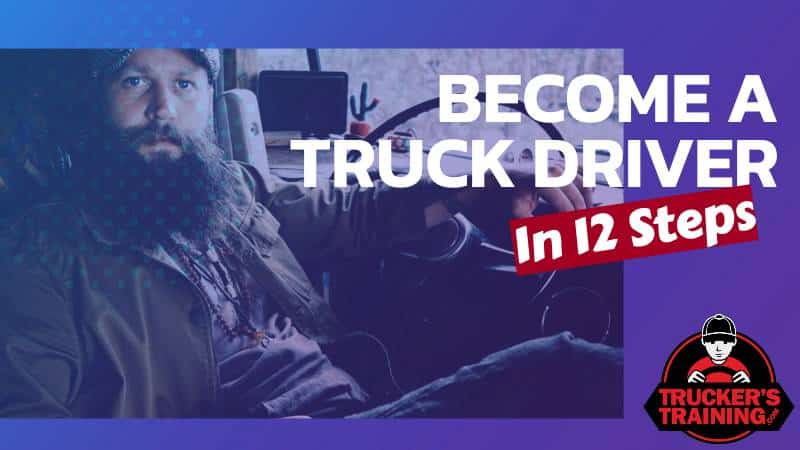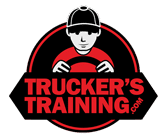Want to become a professional truck driver? Here are the steps to do it.
Getting your Commercial Drivers License (CDL) and becoming a professional trucker is a highly rewarding opportunity, you get to drive a heavy vehicle across the roads of North America and meet interesting people. There is something for everyone in trucking; it is just a matter of coming up with a plan to get there.
Truck Driver Qualifications
If you are pursuing a career in trucking, there are certain criteria that must be met before you take the first step on being a truck driver.

Requirements to Become a Truck Driver
- Meet truck driving age limit
- Hold a non CDL license
- 1 to 2 years driving experience
- No active suspensions
- Valid certificate from medical examiner
Become a Truck Driver in 12 Steps
Gather Paperwork
 Step 1 – Get Your State Commercial Drivers License Manual
Step 1 – Get Your State Commercial Drivers License Manual
Your state’s CDL manual is the one most accurate source of information about getting a CDL. You should use your state’s CDL handbook to prepare for the knowledge and skills tests.
You should read the handbook as part of your preparations and planning process; it will help to determine what level of CDL you need for the jobs that you will be seeking, and which endorsements you will need.
 Step 2 – Decide Which CDL and What Truck You Want to Drive
Step 2 – Decide Which CDL and What Truck You Want to Drive
There is more than one way on how to be a truck driver, and the licensing system reflects the variety of driving jobs that are available. The first thing is to look at the types of careers, such as hauling truckloads over the road, regional driving between depots with mixed loads, and many others too varied to describe here.
The CDL classifications of A, B, and C determine the maximum size and type of vehicle that you will be legally allowed to operate.
- Class A – CDL has the least restrictions; it enables you to drive tractor-trailer combinations, vehicles of all sizes and weights over 26,001 pounds.
- Class B – will allow you to drive single vehicles over 26,001 pounds.
- Class C – enables you to drive vehicles that do not meet the criteria for Class A or B but either carries hazardous materials or sixteen or more occupants including the driver.
Find out which one you will need and what endorsements and restrictions will apply; that will determine the details of your plan to acquire your CDL. It is a smart strategy to attempt to gain the highest level of qualification. So, if you earn the Class A with air brakes and other endorsements, you will have the flexibility to apply for a wider range of positions, even if your first job only requires that you have a Class B or C.
The next part of your plan must include finding a suitable vehicle in which to take the driving skills test, one that meets your CDL classification requirements. You will need to borrow, rent, or sign out from your workplace a tractor-trailer rig, a cargo van, or some other appropriate commercial vehicle in which to practice driving and take the Skills Test.
 Step 3 – Gather Your Personal Documents
Step 3 – Gather Your Personal Documents
You will need your state private drivers license and your social security card as proof of identification. Trucking is a heavily regulated industry so prepare to supply information both to get your CDL and throughout your truck driving career.
 Step 4 – Documents Held On Record
Step 4 – Documents Held On Record
Request your driving record: Your state Department of Motor Vehicles will provide your ten-year driving history upon request, this is a printout of your official driving record.
It is worth noting that if you are presently serving or a veteran of the United States military or Coast Guard, you may want to take advantage of benefits available in return for your service to the country. You will need to have your military I.D. card or your form DD214 available as well, so get that out now too. If you do not have a copy of this document, you can request it from the National Archives.
 Step 5 – DOT Medical Card
Step 5 – DOT Medical Card
It is time to find out if you are fit enough to become a commercial driver. Get this over with early on, particularly if you think you might not be fit enough. The certifying doctor may grant your card while you have certain mild conditions, such as hypertension. Ask your physician if you think there might be a condition that will limit your CDL potential.
As a trucker you will have to take a physical exam every two years, it is not a complicated process, just the time and effort to find and visit a local health care facility with a medical examiner, certified to sign off on the health records of truck drivers.
 Step 6 – Threat Assessment Background Check
Step 6 – Threat Assessment Background Check
If you intend to seek a position where you need a CDL endorsement for hazardous materials (HAZMAT) the Transportation Security Administration requires a background check before they approve you to do so, for which there is a fee.
 Step 7 – Prepare For Drug Testing
Step 7 – Prepare For Drug Testing
You will also face drug testing when you are applying for positions and at random intervals after that. You can expect that your employer will send you for a drug test when you least expect it, as often as yearly. You will also take a drug test after any accident, regardless of whether it was your fault or not.
Commercial Learners Permit (CLP)
 Step 8 – Learn the Handbook
Step 8 – Learn the Handbook
The written examination will include the general driving test that you took for your private license, the commercial driving written test, the test for the endorsements for which you wish to qualify, and every level or endorsement that you already possess.
For example, if you apply for the Class-A test with airbrakes endorsement, and you have a motorcycle endorsement currently, you will have to take the written motorcycle exam again too, so prepare accordingly.
 Step 9- Take the Knowledge Tests
Step 9- Take the Knowledge Tests
You can walk into one of your state’s DMV field offices and apply to take the test the same day. However, you will probably have to sit and wait for hours. A better choice is to make an appointment and show up in advance of the allotted time.
Visit your state DMV Website. Look for instructions and forms, and a set of knowledge test examples on which to practice. For example: these from the California DMV. When you pass the knowledge tests the DMV will award you a commercial license permit (CLP) to train for the Skills Test under supervision.
Note: Effective February 7, 2022, new drivers must meet the minimum requirements for training (ELDT) before they are allowed to take certain CDL skills or knowledge tests.
 Step 10 – Apply for a CDL Skills Test Appointment
Step 10 – Apply for a CDL Skills Test Appointment
After you earn your CLP, you’ve taken strides on how to become a truck driver. You can then apply to take the driving examination. You can schedule your driving test after a minimum two-week waiting period, but waiting times for appointments in your area may be considerably longer. Additionally, you may be able to take the knowledge test at your nearest DMV field office. Take note that you may find that only a small number of specially designated field offices perform CDL testing.
 Step 11 – Take the Skills Test
Step 11 – Take the Skills Test
The inspector will conduct the Skills Test in three phases: Vehicle Inspection, Controls Test, and then after you have passed the first two you will head out for a Road Test. See your state CDL Handbook for details.
Warning: The vehicle you drive during the skills test will set the limit for the license you receive. For example, if it has an automatic transmission, it will state that as a limitation to your license when you get it. Or it might restrict you with a vehicle weight limit, or both. That could be a factor in determining your career after you pass the skills test.
 Step 12 – Get Your CDL License
Step 12 – Get Your CDL License
If you are like most candidates who have just passed the Skills Test, you will feel elated as you park the vehicle. There is one final bureaucratic step in the process. Take your approved documentation to the desk at the field office for final processing. Depending on the department’s workload and your state’s rules, you may get your license on the spot. Otherwise, they may send it to your home address.
Helpful resources:
You’re Licensed to Be a Truck Driver
Whether you do it through a driving school or you bootstrap your way, you made the right choice. Completing the twelve steps on how to become a truck driver, allows you to be a licensed commercial driver! If a job is waiting, that is a good thing. Your CDL is an excellent asset that will help win the trucking job that you want.
Other resources:

Geoff is a freelance writer at TruckersTraining.com with 20+ years of experience driving trucks and buses, dispatching, supervising, and training commercial driving teams. His expertise is writing topics on the transportation and trucking industry, and information technology trends.

 Step 1 – Get Your State Commercial Drivers License Manual
Step 1 – Get Your State Commercial Drivers License Manual Step 2 – Decide Which CDL and What Truck You Want to Drive
Step 2 – Decide Which CDL and What Truck You Want to Drive Step 3 – Gather Your Personal Documents
Step 3 – Gather Your Personal Documents Step 4 – Documents Held On Record
Step 4 – Documents Held On Record Step 5 – DOT Medical Card
Step 5 – DOT Medical Card Step 6 – Threat Assessment Background Check
Step 6 – Threat Assessment Background Check Step 7 – Prepare For Drug Testing
Step 7 – Prepare For Drug Testing Step 8 – Learn the Handbook
Step 8 – Learn the Handbook Step 9- Take the Knowledge Tests
Step 9- Take the Knowledge Tests Step 10 – Apply for a CDL Skills Test Appointment
Step 10 – Apply for a CDL Skills Test Appointment Step 11 – Take the Skills Test
Step 11 – Take the Skills Test Step 12 – Get Your CDL License
Step 12 – Get Your CDL License